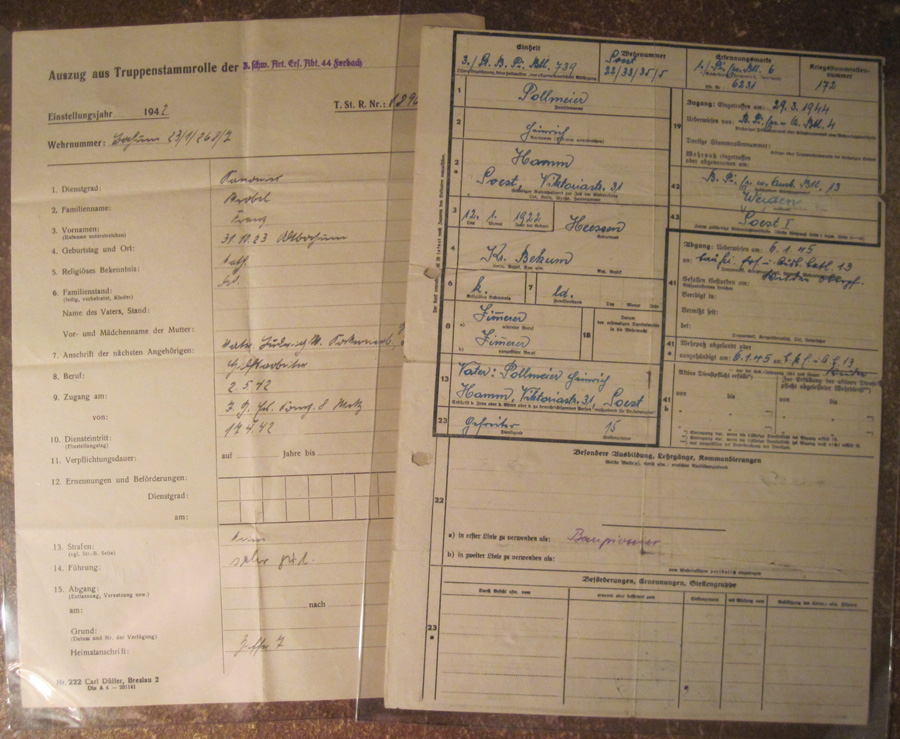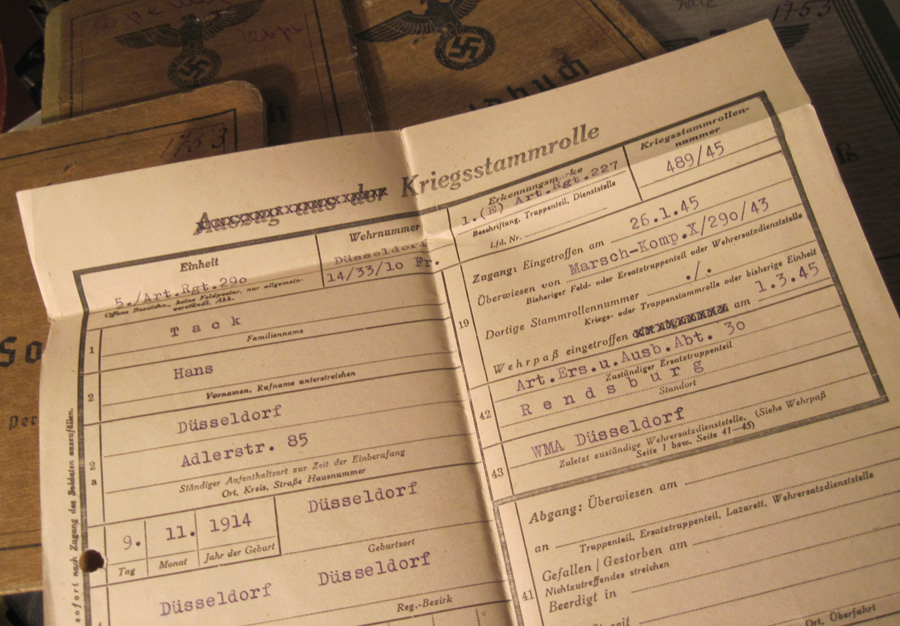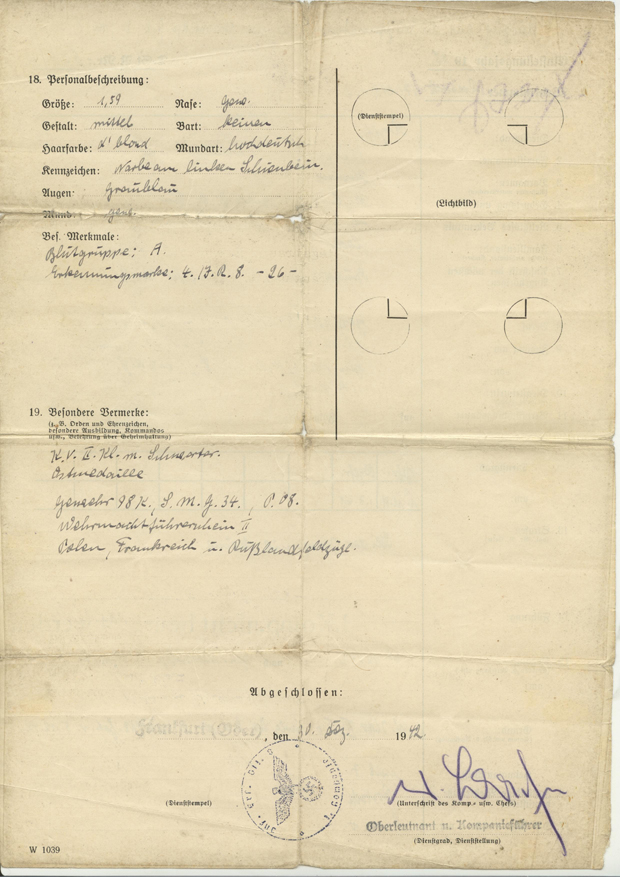A roster is one of the most basic fuctional things a clerk in a reenactment unit can create. In the Wehrmacht, the roster was called the Truppenstammrolle. It took the form of a 2-ring, A4 size binder with a page for each member of the unit. The page that was filled out for each soldier was a double-sided form, called the Truppenstammrollenblatt. This page recorded all kinds of pertinent details about each soldier. Maintaining this record was one of the duties of the 1. Schreiber working under the Hauptfeldwebel.
A Truppenstammrolle is quite a handy thing to have from a reenactment paperwork perspective. It is invaluable to the unit clerk or Hauptfeldwebel. Maintaining these records for each soldier is authentic and a great way to keep track of personal details of each member, stuff that is very handy when filling out the Soldbuch, writing Feldpost letters, filling out award documents, etc.
The first thing you will need is an actual binder. Fortunately, the German company Leitz still makes binders of the type used in the period. They are not absolutely perfect, but they don’t look too terribly modern, with the exception of the spine label (which is easy to fix). In America, these binders are sold by a company called Empire Imports. They are located in Belchertown, Massachusetts, but will ship anywhere. A binder with a 2″ spine will suffice to maintain the records of a Kompanie. Empire Imports has a binder they describe as “Leitz R50 Black Marbled A4 Binder 2 inch spine” that is ideal.
Now, about that spine label. The one that comes on there needs to be carefully removed, as thoroughly as possible. I don’t have an original binder label to copy so I created a fantasy label that I regard as usable. I took the artwork from a wartime advertisement for an office supply place in Berlin that serviced typewriters- the company logo, address and phone number are precisely copied from the wartime original art. I print this out on a light gray recycled paper. Here is a printable PDF of these labels.
Once you get the binder, you will need the Truppenstammrollenblatt pages. I’ve got a PDF for that too, but first, some information about these. I find them fairly often in groupings of ID paperwork, usually tucked into the Soldbuch. In these cases these documents, which have many variations, are usually marked “Auszug aus der Truppenstammrolle” (Excerpt from the Truppenstammrolle). For some reason, copies of the information kept in the Truppenstammrolle must have been handed to individual soldiers at times, perhaps in cases of transfers, or as a provisional sort of ID. Here are a couple original examples of these documents from paperwork groupings I have- these documents have some slight differences and may have been for slightly different purposes.

Here is one that was pre-printed “Auszug aus der Truppenstammrolle” but the “Excerpt…” part has been “X”ed out with a typewriter, meaning this page was kept as part of the actual unit roster at one time.

Here are front and back scans of another original. The form itself was not marked for a purpose but “Auszug aus der Truppenstammrolle der Marschkp. G. E. B. (m.) 8” is hand-written at the top- “Excerpt from the Roster of Transport Kompanie, Grenadier Ersatz Bataillon (mot.) 8”. I believe this document could have been used either as an excerpt to be handed to the soldier, or as part of the unit roster, punched and kept in a binder.


Here is a PDF I made from that original. It has not been re-typeset, the lettering has been exactly copied from the original. It is sized to be printed on A4 size paper, if you do not have A4 paper you can buy a sketch pad or “scribble pad” that is 9″ x 12″ and trim the paper to the correct size, 210 mm × 297 mm.
Once you get these printed out on some appropriate paper, it is just a matter of filling one out for each man. Here is what the entries mean, top to bottom, front to back.
(at top) Unit roster number:
Recruitment year 19….
Wehrnummer: (as recorded at the bottom of Page 1 in the Soldbuch)
1. Rank:
2. Last name:
3. First names: (if more than one, underline the one he is called)
4. Birth date and place of birth:
5. Religion:
6. Marital status and number of childern:
7. Address of the next of kin:
8. Occupation:
9. Entered unit on:
From: (training unit, etc.)
10. Date of induction into the military:
11. Duration of service:
12. Appointments and promotions:
Rank:
Promoted on:
13. Punishments:
14. Conduct:
15. How did soldier leave unit (discharge, transfer etc.): To:
Date of leaving unit:
Reason: (date and number of order)
16: Current recruiting district:
17: “DB liegt-nicht-vor:” Indicates whether or not the soldier has a preexisting service-related injury (Dienstbeschädigung).
Page 2- Space for a photo at top right
18: Personal description:
Height: Nose:
Build: Facial hair:
Hair color: Dialect:
Distinguishing marks:
Eyes:
Mouth:
Special characteristics:
19: Special notes: for example medals and awards, special training, missions, etc.
Page 2 bottom: Date the record was closed.
With that out of the way, let’s take a second look at the original I copied, to get some ideas about how to fill this out (please refer back to the scans posted above).
This one was for an Obergefreiter, Heinz Klöppel, recruited in 1938. This page is from the roster of a Grenadier replacement unit, he came to this unit on 18.12.42 from a convalescent Kompanie and left on 30.12.42 to a convalescent Marschkompanie. His marital status is “led.” (ledig, single), his next of kin is his brother, his home address is listed as the same as his next of kin. Section 11, for duration of service, is just marked with a “not applicable” symbol; Klöppel was in the Wehrmacht for the duration of the war. On the back we see his dialect listed as “hochdeutsch” (High German), under special characteristics the clerk has listed his blood type and ID disc number. Special notes include the awards the soldier had earned (War Merit Cross 2. Class and the Eastern Front Ribbon), the weapons he was trained on, the fact that he had a drivers license, and the campaigns in which he had fought: “Polen, Frankreich u. Russlandfeldzüge” (Poland, France and Russia campaigns).
As a clerk in a reenactment unit, you can make this project as complicated or as simple as you want. The only rubber stamp you need is the round service stamp for the unit you portray. The Wehrmacht clerks had no issues with leaving sections blank. Add a photo to each page, or don’t. Fill them out with a typewriter, or by hand, with a pen. It’s up to you, have fun with it!